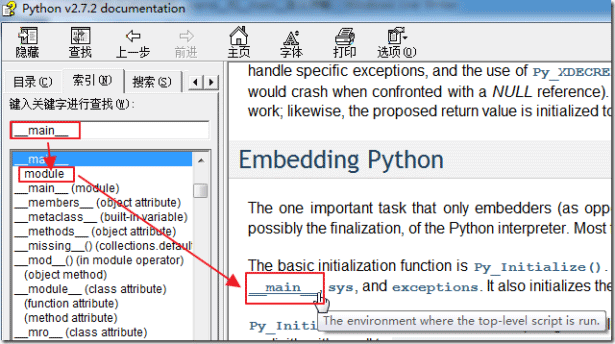您好,登錄后才能下訂單哦!
您好,登錄后才能下訂單哦!
這篇文章主要介紹“python特殊屬性及方法怎么用”的相關知識,小編通過實際案例向大家展示操作過程,操作方法簡單快捷,實用性強,希望這篇“python特殊屬性及方法怎么用”文章能幫助大家解決問題。
在python中,以單下劃線開頭的(_a)的代表不能直接訪問的類屬性,需通過類提供的接口進行訪問,不能用“from xxx import *”而導入,“單下劃線” 開始的成員變量叫做保護變量,意思是只有類對象和子類對象自己能訪問到這些變量;以雙下劃線開頭的(_ _a)代表類的私有成員,意思是只有類對象自己能訪問,連子類對象也不能訪問到這個數據;以雙下劃線開頭和結尾的(_ _a_ _)代表python里特殊方法專用的標識,如 _ _init_ _()代表類的構造函數。
如果是一個對象的調用,則表示類的名稱,而不是表示對象的名稱;如果當前模塊被直接執行(主模塊),_ _ name _ _ 存儲的是_ _ main _ _ ;如果當前模塊是被調用的模塊(被導入),則_ _ name _ _存儲的是py文件名(模塊名稱)。
1、表示對象的名稱
>>> class A(object): a = 1 def __init__(self): self.b = 'c' >>> a = A() >>> A.__name__ 'A' >>> a.__name__ Traceback (most recent call last): File "<pyshell#7>", line 1, in <module> a.__name__ AttributeError: 'A' object has no attribute '__name__'
2、表示_ _ main _ _函數的名稱,也就是程序的入口,類似于java中main函數

>>> __name__ '__main__'
3、如果當前模塊被其他模塊調用,則是當前模塊的名稱
demo1.py
print(__name__)
demo2.py
import demo1
運行demo2.py文件后,得到的結果為:
demo1
_ _ bases _ _ 表示類的所有基類;_ _ base _ _ 輸出類繼承的第一個父類(類的基類); _ _ mro _ _ 輸出類的層次結構。
>>> class A: def __init__(self): self.a = 2 >>> class B(A): def __init__(self): super().__init__() self.b = 3 >>> class C(A): def __init__(self): super().__init__() self.c = 4 >>> class D(B, C): def __init__(self): super().__init__() self.d = 5 >>> D.__bases__ (<class '__main__.B'>, <class '__main__.C'>) >>> D.__base__ <class '__main__.B'> >>> D.__mro__ (<class '__main__.D'>, <class '__main__.B'>, <class '__main__.C'>, <class '__main__.A'>, <class 'object'>)
表示對象的類型,相當于type()函數。
>>> class A: def __init__(self): self.a = 2 >>> a = A() >>> a.__class__ <class '__main__.A'>
表示對象和類的一些屬性,用一個字典存儲起來。
>>> class A:
a = 1
b = 2
def __init__(self):
self.c = 3
self.d = 4
>>> a = A()
>>> a.__dict__
{'c': 3, 'd': 4}
>>> A.__dict__
mappingproxy({'__module__': '__main__', 'a': 1, 'b': 2, '__init__': <function A.__init__ at 0x000001CD66F6B8B0>, '__dict__': <attribute '__dict__' of 'A' objects>, '__weakref__': <attribute '__weakref__' of 'A' objects>, '__doc__': None})表示類的所有直接子類。
>>> class A: def __init__(self): self.a = 2 >>> class B(A): def __init__(self): super().__init__() self.b = 3 >>> class C(A): def __init__(self): super().__init__() self.c = 4 >>> class D(B, C): def __init__(self): super().__init__() self.d = 5 >>> C.__subclasses__() [<class '__main__.D'>] >>> A.__subclasses__() [<class '__main__.B'>, <class '__main__.C'>]
_ _ new _ _ ()是一個靜態方法,用于根據類型創建實例。Python在調用 _ _ new _ _ ()方法獲得實例后,會調用這個實例的_ _ init _ _ ()方法,然后將最初傳給 _ _ new _ _ ()方法的參數都傳給 _ _ init _ _ ()方法。
_ _ init _ _ ()是一個實例方法,用來在實例創建完成后進行必要的初始化,該方法必須返回None。Python不會自動調用父類的 _ _ init _ _ ()方法,這需要額外的調用:
super(C, self). _ _ init _ _ ()
_ _ new _ _ ()至少要有一個參數cls,代表要實例化的類,此參數在實例化時由Python解釋器自動提供;_ _ new _ _ ()必須要有返回值,返回實例化出來的實例,可以return父類new出來的實例,或直接是object的new出來的實例。
>>> class A(object):
def __new__(cls, *args, **kwargs):
print("__new__")
instance = object.__new__(cls)
# 或者
# instance = super().__new__(cls)
return instance
def __init__(self):
print("__init__")
>>> a = A()
__new__
__init__在GC之前,Python會調用這個對象的 _ _ del _ _ ()方法完成一些終止化工作。如果沒有 _ _ del _ _ ()方法,那么Python不做特殊的處理;此外,Python無視_ _ del _ _ ()方法的返回值;Python不會自動調用父類的 _ _ del _ _ ()方法,除非顯式調用;定義了 _ _ del _ _ ()方法的實例無法參與到循環GC中,所以對于這樣的實例應該避免循環引用;try/finally語句或with語句可能是比_ _ del _ _()更好的方式。
>>> class A(object):
def __new__(cls, *args, **kwargs):
print("__new__")
instance = super().__new__(cls, *args, **kwargs)
return instance
def __init__(self):
print("__init__")
def __del__(self):
print("__del__")
>>> a = A()
__new__
__init__
>>> del a
__del___ _ repr _ _ ()是一個 ”自我描述“ 的方法,也是Python類中的一個特殊方法,由object對象提供,由于object提供的這個 _ _ repr _ _ 方法總是返回一個對象, ( 類名 + obejct at + 內存地址 ),這個值并不能真正實現自我描述的功能,如果你想在自定義類中實現 “自我描述” 的功能,那么必須重寫 _ _ repr _ _ 方法。_ _ repr _ _ ()方法返回的字符串主要是面向解釋器的。
>>> class A(object): def __repr__(self): return "this is a class A" >>> a = A() >>> a this is a class A >>> print(a) this is a class A >>> str(a) 'this is a class A'
_ _ str _ _ ()與_ _ repr _ _ ()返回的詳盡的、準確的、無歧義的對象描述字符串不同,_ _ str _ _ ()方法只是返回一個對應對象的簡潔的字符串表達形式。如上代碼所示,當_ _ str _ _ ()缺失時,Python會調用_ _ repr _ _ ()方法。
>>> class A(object): def __str__(self): return "this is a class A" >>> a = A() >>> a <__main__.A object at 0x000001CF8C8F9640> >>> print(a) this is a class A >>> str(a) 'this is a class A'
實際上_ _ str _ _ ()只是覆蓋了_ _ repr _ _ ()以得到更友好的用戶顯示。Python內置的str()函數,print(x)語句,都會調用對象的_ _ str _ _()方法。
>>> class A(object): def __repr__(self): return "class A" def __str__(self): return "this is a class A" >>> a = A() >>> a class A >>> print(a) this is a class A >>> str(a) 'this is a class A'
定義了該方法的對象可以像函數那樣被調用,因此被稱為可調用對象。
>>> class A(object): def __init__(self): self.a = 2 def __call__(self, b, *args, **kwargs): c = b + self.a return c >>> a = A() >>> a(3) 5
當兩個對象x、y分別進行x<y、x<=y、x>y、x>=y、x==y和x!=y運算時,會調用對應的函數。
>>> class A(object):
def __init__(self, b):
self.b = b
def __lt__(self, other):
print("__lt__")
return self.b < other.b
>>> c = A(3)
>>> d = A(4)
>>> c < d
__lt__
True三種情形會調用__hash__()方法:1. 內置的hash()方法,2.作為字典的鍵時,3.作為集合的成員時;_ _ hash _ _ ()方法應該返回一個32位長的整數,對與同一個對象,hash()方法應該總是返回相同的值;對于 x == y ,即使二者不屬于相同的類型,只要他們是可哈希的(hashable),都應該確保得到 hash(x) == hash(y) ;
>>> class A(object): def __init__(self, n): self.n = n def __eq__(self, other): return self.n == other.n def __hash__(self): return random.randint(0, 10) >>> a = A(3) >>> b = A(3) >>> a == b True # 雖然a == b返回結果為True,但是hash(a)和hash(b)返回結果不一樣,所以不能說這兩個對象是相同的。 >>> hash(a) 3 >>> hash(b) 5
_ _ eq _ _()正確的用法:
class A(object): def __init__(self, n): self.n = n def __hash__(self): return hash(id(self)) def __eq__(self, other): if isinstance(other, self.__class__): return hash(id(self))==hash(id(other)) else: return False
通過_ _ hash _ _ 返回一個int值,用來標記這個對象。對于類而言,如果沒有實現_ _ eq _ _ ()和 _ _ hash _ _ ()函數,那么會自動繼承object._ _ hash _ _()。
關于“python特殊屬性及方法怎么用”的內容就介紹到這里了,感謝大家的閱讀。如果想了解更多行業相關的知識,可以關注億速云行業資訊頻道,小編每天都會為大家更新不同的知識點。
免責聲明:本站發布的內容(圖片、視頻和文字)以原創、轉載和分享為主,文章觀點不代表本網站立場,如果涉及侵權請聯系站長郵箱:is@yisu.com進行舉報,并提供相關證據,一經查實,將立刻刪除涉嫌侵權內容。